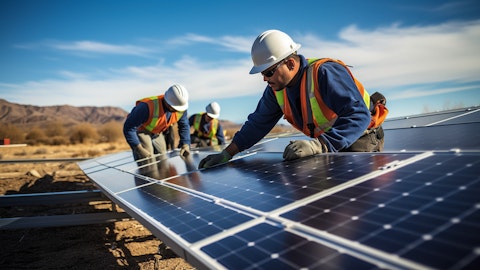It just seems like structurally, margins here are lower even if you do get back to the $600 million to $700 million revenue level. What’s kind of driving that? And maybe help us reconcile it a bit? And why can’t you maybe take more cost out of the system? Because it feels like you’ve just — again, margins are — now the target is lower than what you had prior, because prior you weren’t including 500 basis points from IRA?
Ronen Faier: Sure, Brian, and thanks for the question. So in general, I think that there are two areas here. One I will start by saying is that as we mentioned from the very beginning, the way that we are looking at this normalized level is a level that we see as a base, based on the point of sale data that we saw in Q3 across the board, which we by the way believe that, again, we took it out of being cautious here after what we saw at least in the last month and a half actually or months ago. And therefore, we are still trying to evaluate whether this normalized level is really the new level that we’ll go for several years from that point, or that maybe in some cases, this should be actually a little bit of a higher rate. And that means that from adjusting our expense level is something that we are going to look very cautiously at each and every expense, making sure that we are making all the necessary adjustments and that we are taking all cost reduction activities that we’re able to do, but not returning to a situation that if the market is going up.
And we did see this boom bust, sometimes cycles within this market, we’re finding ourselves again having to chase after capacity and having to airship product, because again this is something that we’ve seen in the last years as well. So I would say that from the beginning, while modeling, we took a very cautious approach into how we should build our expense base and how we are going to operate the company assuming that this is not necessarily the level that we will see two or three quarters down the road. It doesn’t mean — and I think that that’s the big difference between modeling and actually going into the real world assumption, it doesn’t mean that we will not do whatever effort needed in order to make sure that we are indeed capitalizing on every cost reduction activity that we can do.
But we wanted to be a little bit more cautious in modeling here. So that’s I would call it from the very beginning the limitation of the module itself. The second element that we need to take here is the fact that we do see that our commercial percentage within our portfolio continues to grow. As mentioned before, in this quarter, 66% of the megawatt shipped was actually commercial products. This is the record high that we see. Maybe it’s a little bit tilted towards commercial because of the fact that these were products that we were lacking because of components before. But still, we do see that at least in the commercial applications, we’re getting stronger. Our offering is good. And we’re growing. And we wanted to give a little bit of attention to this as well.
And the last thing that’s related here is the fact that we do expect that we will continue to see maybe a little bit more growth in other areas that will allow us to grow a little bit further, like new products. And again, while we don’t put the revenue here being conservative, these are usually products that are characterized with at least at the beginning lower gross margin. So in general, I would say that we try to be here a little bit more conservative in the way that we are modeling things. We will be making every effort to adjust to the new level as we see it, and of course we will learn as long as we’re moving. And by the way, we intend to continue and give you in the next call a little bit of color about how do we see the normalized level because we do believe that we will get more information and this increase in commercial that will also allow us by way to increase the revenue base is something that we see.
In general, I can tell you that we’re aiming to get of course to the highest profitability possible and higher margins possible. And this will be our action for the next two to three quarters.
Brian Lee: Okay. I appreciate that additional context. And then just maybe kind of a follow up to some of the earlier questions, I could see investors growing concern that this is more than just an inventory correction given the magnitude and also the duration. Like, how do you think about the share position here, whether in U.S. or Europe or both? Like can you provide some evidence or data points or anything that gives you the comfort that this is everyone going through the same correction versus maybe there is some share loss here that you guys are experiencing? And one of the things I guess we hear a lot about is there are two peers, like SMA and Sungrow, who have had recent updates that were relatively positive. I know they’re not all positive in the universe space these days. But just maybe give us a sense of what you see out there data wise, feedback wise that gives you comfort it’s not a share issue at all? Thank you.
Zvi Lando: Yes. Thanks, Brian. Obviously, it’s something that we look at very closely. And I’ll give you a data point that is — it’s subjective and it’s worth what it is and focusing on the markets that we serve. Obviously, we don’t serve the utility market and we don’t — so some of the names that you’re referring to are related to dynamics in the utility market that are different. But we recently sampled with one of the largest European distributors in the world. I’ll take a step back actually. Related also to what I said in my earlier comments, in the latter part of 2022, we definitely sense that we were losing share just based on availability. So the demand was very strong for our products. We couldn’t supply all of it.
And there were installers that in the urgency to install that were long-term SolarEdge installers tried other products. We mapped that out. And once availability became less of a concern for us, we in a systematic way in every country identified the installers that we knew based on our monitoring system have decreased their usage of SolarEdge because of lack of availability, and have been going back and recovering those one by one to be using SolarEdge once availability was no longer constrained. And recently, we sat with one of the largest distributors, a pan European distributor and went through their share picture from inverter suppliers’ point of view. And this also relates to something that I mentioned in the call last quarter that during periods of shortage, people bring on and they widen their line card to include more brands.
And then as the market goes back to normal, they reduce the line card. And with this distributor, going country by country, overall, we saw — they reported an increase of our share in their sales in 2023. This was in the first eight months of 2023, relative to the same period in 2022. So we’ve been looking at that at a high level of detail. And although there are fluctuations, and as I said, we haven’t recovered all of the share that we lost due to availability in the second half of 2022, we are optimistic about the signs that we’ve been seeing since the beginning of 2023 and recovering that share. So we don’t see that as part of the dynamics that are related to the inventory situation that we described.
Brian Lee: Okay, understood. I’ll pass it on. Thanks, guys.
Ronen Faier: Thank you.
Operator: Our next question is from Colin Rusch of Oppenheimer.





